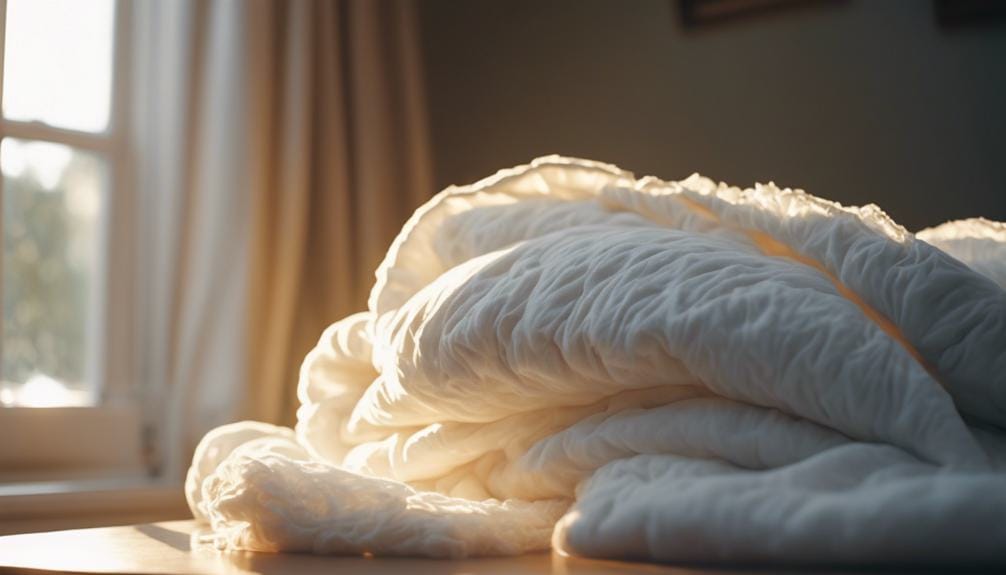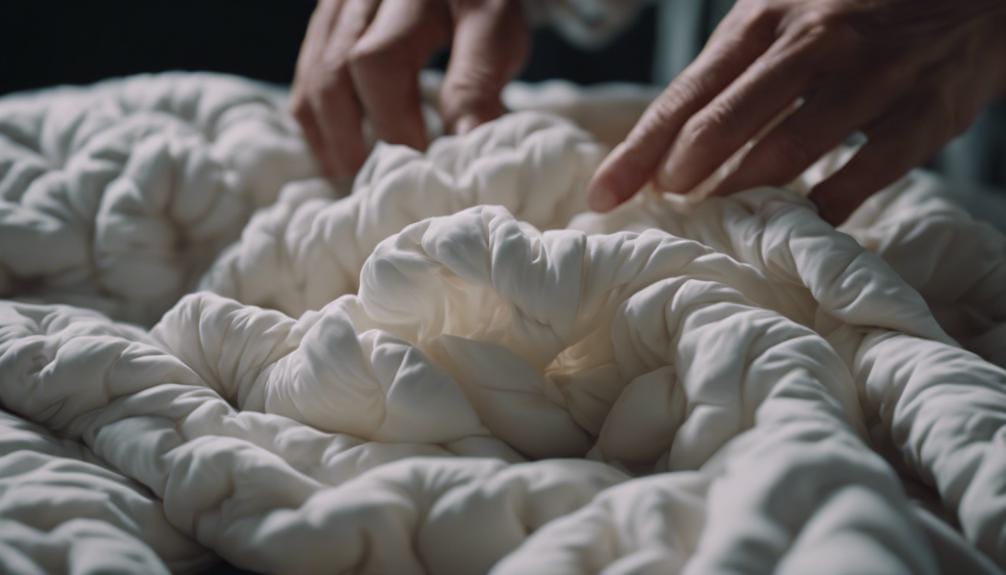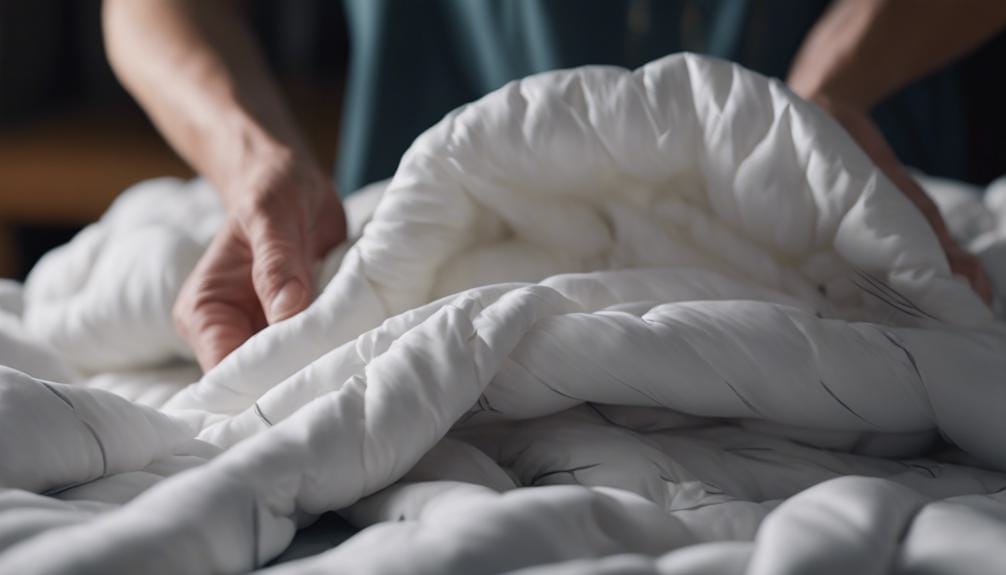How To Get Wrinkles Out Of a Comforter? A Step-By-Step Guide
To get wrinkles out of a comforter, shake it vigorously from all sides and corners. Fluff it up with quick, firm motions. Hanging it outside after shaking can help too. Adding clean tennis balls while hanging aids in the process. Regular maintenance keeps the comforter in peak condition. Remember, we all need a little shake and fluff sometimes.
Shake Out the Comforter
To effectively remove wrinkles from a comforter, shake it vigorously from all sides and corners. This method helps distribute the filling evenly and smooths out the surface.
Use quick, firm motions to fluff up the comforter, which also helps prevent wrinkles from setting deeply. After shaking, hang the comforter outside to further aid in wrinkle removal.
Adding clean tennis balls while hanging can improve this process. Regular maintenance like this keeps the comforter in optimal condition.
Prepare the Dryer
After cleaning the dryer’s lint trap to maintain good airflow, set the dryer to a low or medium heat. This prevents damage to the comforter’s fabric due to excessive heat.
Before drying, spray the comforter lightly with water to help smooth out wrinkles.
Consider using dryer balls to improve drying efficiency. These tools help separate fabrics, allowing heated air to circulate more effectively and reduce drying time.
Use Tennis Balls

To effectively remove wrinkles and fluff up a comforter in the dryer, add clean tennis balls. These balls distribute the heat more uniformly, preventing the filling from clumping together. They also serve as natural fabric softeners.
This technique not only maintains the loftiness of the comforter but also enhances the drying process by improving airflow, which in turn reduces moisture and prevents odors. Using tennis balls is a practical and economical way to care for your bedding.
Check Every 30 Minutes
During the drying process for your comforter, it’s important to check it every 30 minutes. This ensures even drying and prevents wrinkles.
Frequent checks also stop the fabric from overheating, which can preserve the smooth texture. Additionally, fluffing the comforter during these checks helps maintain its shape and prevents any lumps from forming.
This methodical approach aids in achieving a wrinkle-free and well-dried comforter.
Remove Promptly

To avoid wrinkles, remove the comforter from the dryer as soon as it’s done. Shake it well and fluff it to keep it smooth. Don’t let it sit crumpled or folded; this can cause permanent creases.
Hanging the comforter right after drying will help it stay wrinkle-free. Consistently caring for your comforter after each wash ensures it remains in good condition.
Lightly Mist With Water
To remove wrinkles from a comforter, first fill a spray bottle with warm water. Spray the wrinkled areas lightly. After misting, pull the fabric taut to smooth out the creases. Let the comforter air dry to eliminate any remaining wrinkles.
If desired, add a small amount of fabric softener to the water for a fresh scent. This method is effective because the moisture helps relax the fabric fibers, making them easier to reshape.
Additional Fluffing

To increase the plumpness and comfort of your comforter, adopt these practical fluffing methods. Shake the comforter gently to evenly distribute the filling. Massaging and patting the comforter can also help in reviving its loftiness. Placing the comforter in the dryer with tennis balls effectively fluffs the filling.
Regular fluffing is essential to prevent clumping and maintain the comforter’s softness. This approach not only enhances comfort but also extends the comforter’s lifespan by ensuring even wear.
Avoid Overheating
Overheating can severely damage your comforter, affecting both its fabric and filling. To safeguard its quality, avoid using hot dryers or irons directly on the comforter. High heat can cause the materials to shrink or become misshapen. It’s important to use gentle heat settings when washing and drying to maintain the comforter’s original fluffiness and shape.
| Avoid Overheating | Impact |
|---|---|
| Using hot dryers | Fabric damage |
| Using irons | Filling damage |
| High temperatures | Reduced fluffiness |
| Shrinking material | Altered shape |
| Gentle heat settings | Preserved quality |
Maintaining the right care regimen extends the life of your bedding and ensures ongoing comfort.
Prevent Clumping

To prevent your comforter from clumping, shake it gently after washing to keep the fill even. Use low heat when drying to preserve the fluffiness. Adding clean tennis balls or dryer balls during the drying cycle helps prevent the fill from bunching.
Using a high-capacity washer ensures thorough cleaning and helps avoid clumping. Fluff the comforter periodically throughout the drying cycle to stop clumps from forming.
Stubborn Wrinkles
After solving clumping issues during the washing and drying phases, removing stubborn wrinkles from a comforter requires specific strategies. Deep creases often need particular treatments.
You might need to try several methods to effectively smooth out these persistent wrinkles. If typical techniques don’t work, consider professional cleaning or steaming services as an alternative.
Persistence and regular effort are essential in managing tough wrinkles in a comforter.
Frequently Asked Questions
How Can I Get the Wrinkles Out of My New Comforter?
When dealing with wrinkles on a comforter, we suggest lightly misting it with water and then drying it on a low heat setting. This method helps to release wrinkles effectively without damaging the fabric.
How Do You Get Wrinkles Out of Bedding Without Ironing It?
We use methods like steaming, hanging to dry, or adding a damp towel in the dryer to smooth out bedding wrinkles without ironing. Spritz lightly with water, smooth by hand, tumble dry with dryer balls, or opt for wrinkle-guard fabric softener for best results.
How Do You Get Wrinkles Out of 100% Polyester Comforter?
We find that using a gentle steaming method is effective for removing wrinkles from 100% polyester comforters. Avoid high heat settings to prevent damage. Hanging the comforter in a steamy bathroom can also help release wrinkles.
Can I Steam My Comforter?
Yes, we can steam a comforter. It’s a gentle and efficient method to remove wrinkles. A steamer can easily flatten wrinkles without damaging the fabric. Steaming over a shower rod reaches all areas effectively.
Conclusion
To remove wrinkles from a comforter effectively, follow these straightforward steps.
First, shake out the comforter to distribute the filling evenly.
Next, place it in the dryer with a couple of tennis balls to help fluff it up.
Make sure to check the comforter periodically while drying to ensure it doesn’t overheat or clump.
Remove it from the dryer as soon as it’s dry to avoid setting wrinkles.
Following these steps will help you achieve a smooth and comfortable comforter for a restful sleep.
